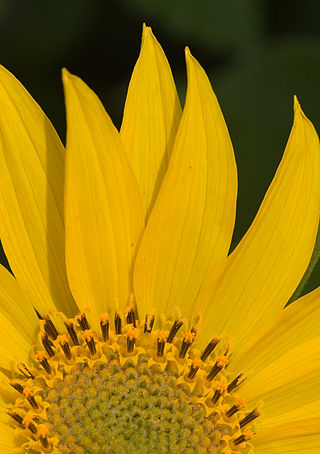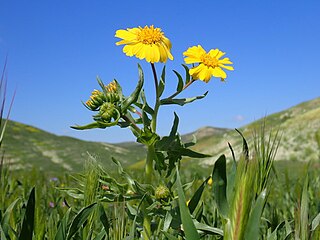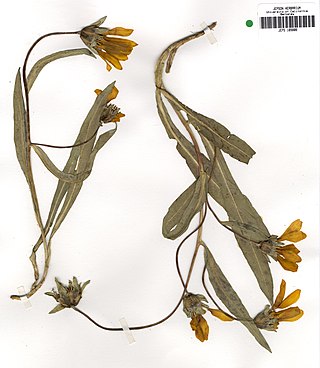Holozonia is a North American genus of flowering plants in the family Asteraceae. It contains only one known species Holozonia filipes, which is known by the common name whitecrown. It is endemic to California.
Isocoma arguta is a rare species of flowering plant in the family Asteraceae known by the common name Carquinez goldenbush. It has been found only in Solano and Contra Costa Counties in California, where it grows in the Sacramento-San Joaquin River Delta. It is a resident of Suisun Marsh. It thrives on alkali flats and other mineral-rich soils.

Layia discoidea is a rare species of flowering plant in the family Asteraceae known by the common name rayless tidytips, or rayless layia.

Balsamorhiza deltoidea is a species of flowering plant in the sunflower tribe of the plant family Asteraceae known by the common name deltoid balsamroot. It is native to western North America from British Columbia to California, where it grows in many types of generally mountainous habitat.

Calycadenia mollis is a species of flowering plant in the family Asteraceae known by the common name soft western rosinweed. It is native to a section of central California, from Tuolumne County do northern Tulare County. There are also isolated populations farther north in Nevada County. The plant grows in a number of habitat types in the Central Valley and adjacent Sierra Nevada foothills.

Calycadenia multiglandulosa is a species of flowering plant in the family Asteraceae, known by the common names sticky calycadenia and sticky western rosinweed. It is endemic to California, where it is a common in the Coast Ranges and in the Sierra Nevada Foothills from Shasta County to Kern County.

Erigeron multiceps is a species of flowering plant in the family Asteraceae known by the common names Kern River daisy and Kern River fleabane. It is endemic to California, where it is known mostly from the Kern Plateau in the southern High Sierra Nevada of eastern Tulare County. It is a perennial herb growing a hairy stem up to about 20 centimeters tall from a taproot and caudex. The base of the stem is surrounded by oblong leaves 2 to 5 centimeters long, and there are some smaller leaves along the length of the stem. The inflorescence produces hairy, glandular flower heads filled with yellow disc florets and a fringe of up to 125 thin, flat white to purple-tinged ray florets. The fruit is an achene with a pappus of bristles.
Eriophyllum congdonii, known by the common name Congdon's woolly sunflower, is a rare California species of flowering plant in the family Asteraceae.

Hieracium argutum is a species of flowering plant in the family Asteraceae known by the common name southern hawkweed.

Holocarpha heermannii is a species of flowering plant in the family Asteraceae known by the common name Heermann's tarweed. It is endemic to California.
Xanthisma junceum is a species of flowering plant in the family Asteraceae known by the common names rush bristleweed or rush-like bristleweed. It is native to northern Mexico and it occurs in the United States only as far north as San Diego County, California. It grows in coastal and inland slopes and canyons. It is a perennial herb growing erect to 1 m in height. The linear leaves are mostly located at the base of the plant, each 1–2 cm long and toothed or cut into bristle-tipped lobes. The inflorescence bears one or more flower heads lined with glandular, bristle-tipped phyllaries. The head has a center of many yellow disc florets and a fringe of 15 to 25 yellow ray florets each about 1/2 cm long. The fruit is a hairy achene 2–3 mm long tipped with a pappus.
Madia anomala is a species of flowering plant in the family Asteraceae known by the common name plumpseeded madia. It is endemic to northern California, where it can be found on hillsides in the San Francisco Bay Area and adjacent mountains and valleys.

Madia exigua is a species of flowering plant in the family Asteraceae known by the common names small tarweed and threadstem madia.

Madia radiata is a species of flowering plant in the family Asteraceae known by the common names golden madia and showy madia. It is endemic to California, where it is known mostly from the Central Coast Ranges and adjacent edges of the San Francisco Bay Area and Central Valley.

Wyethia angustifolia is a species of flowering plant in the family Asteraceae known by the common names California compassplant and narrowleaf mule's ears. It is native to the west coast of the United States from Washington to California, where it grows in grassland, meadows, and other open habitat. It is a perennial herb growing from a tough taproot and caudex unit and producing a stem 30 to 90 centimeters tall. The leaves have lance-shaped blades up to 50 centimeters tall. The inflorescence produces one or more large sunflower-like flower heads at the top of the hairy stem. The head has narrow, hairy phyllaries at the base. It contains up to 21 yellow ray florets each up to 4.5 centimeters long and many yellow disc florets. The fruit is an achene which may be nearly 2 centimeters long including its pappus.

Agnorhiza bolanderi is a species of flowering plant known by the common name Bolander's mule's ears. It is endemic to California, where it is known only from a narrow section of the Sierra Nevada foothills about 275 kilometers long from Shasta County to Mariposa County. It grows in chaparral and grassland habitat, usually on serpentine soils.

Wyethia glabra is a species of flowering plant in the family Asteraceae known by the common name Coast Range mule's ears. It is endemic to California, where it grows in the North and Central Coast Ranges. It is a perennial herb growing from a tough taproot and caudex unit and producing a stem up to 40 centimeters tall. It is hairless to hairy and glandular. The leaves have lance-shaped or oval blades up to 45 centimeters long. The inflorescence is usually a solitary flower head or occasionally a cluster of 2 or more. The head has lance-shaped leaflike phyllaries at the base. It contains up to 21 yellow ray florets each up to 5 centimeters long and many yellow disc florets. The fruit is an achene over a centimeter long, including its pappus.

Wyethia longicaulis is a species of flowering plant in the family Asteraceae known by the common name Humboldt mule's ears. It is endemic to California, where it occurs in the North Coast Ranges and the Klamath Mountains. It grows in mountain and foothill habitat such as grassland and forests. It is a perennial herb growing from a tough taproot and caudex unit and producing a stem up to half a meter tall. It is hairless to hairy and glandular. The leaves have lance-shaped or oblong blades up to 20 centimeters long. They are glandular and have a waxy exudate that dries white. The inflorescence is usually a cluster of 2 to 4 flower heads, each with up to 10 yellow ray florets which may be up to 3 centimeters long. The fruit is an achene about a centimeter long, including its tiny pappus.

Agnorhiza ovata is a species of flowering plant known by the common name southern mule's ears. It is native to the mountains and foothills of southern California and Baja California, occurring the Coast Ranges and Sierra Nevada foothills in Tulare, Kern, Ventura, Los Angeles, Orange, Riverside, and San Diego counties in California, with additional populations in the Peninsular Ranges south of the international border.

Hymenothrix dissecta is a North American species of flowering plants in the family Asteraceae known by the common names yellow ragweed and ragleaf bahia. It is native to the western United States as far north as the Black Hills of South Dakota and Wyoming, as well as in northern Mexico.















